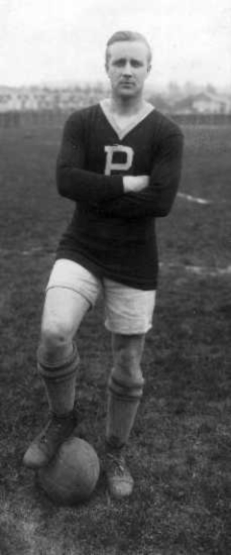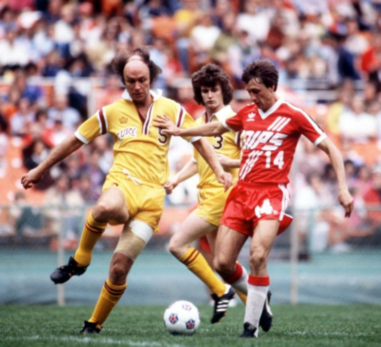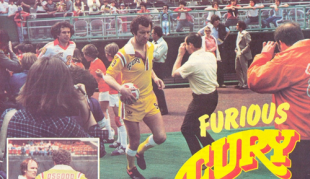Featured image: From the collection of Steve Holroyd
PPL Park will soon play host to the 2012 MLS All-Star game as the league’s best and brightest take on Chelsea, the reigning European Champions League titlists and one of the world’s elite sides.
While today Union fans can only dream of a side that features players such as Fernando Torres, Ashley Cole, and Frank Lampard, there was a time not so long ago that the thought of Chelsea players joining a domestic side was not so farfetched. Indeed, in an era when the current financial landscape was different and English players were subject to a “maximum wage” while U.S. teams could spend freely, American leagues were able to compete in the open soccer market. Along the way, Philadelphia teams have obtained players with a connection to the famous London club.
Harold Brittan: Golden Age Goal Machine
In 1921, a group of the United States’ top club teams ushered in an era of major league soccer with the advent of the first American Soccer League. Bethlehem Steel—the top team in the country throughout the teens—was part of the new league. However, hoping to draw larger crowds than in did in the Lehigh Valley, the Steelmen moved to Philadelphia for the league’s inaugural season. One of the Phillies’ first moves in preparation for the 1921-22 season was to acquire center forward Harold Brittan.
Born in Derby in 1894, Brittan had first played with Chelsea in 1913-14, scoring two goals in only two appearances. The following season, he appeared in 9 games, netting another two goals. He then served three and a half years in the British army during World War I, and did not return to the London club until 1919, appearing 13 times in the 1919-20 season, scoring three goals (including two game-winners over Liverpool).
Dissatisfied with both Chelsea and life in England, Brittan and his family emigrated to the United States in 1920, settling in Philadelphia. Bethlehem Steel signed him in anticipation of the club’s move to the city, hoping he could pick up the goal scoring slack from the aging Bethlehem legend Dougie Campbell.
Brittan appeared in one game for the Steelmen in 1920, scoring one goal. In 1920-21, however, he was around for the whole season, and was extremely productive while leading the Steelmen to the 1921 National Association Football League title. In fact, Chelsea attempted to reacquire its former striker, offering Bethlehem $15,000 for Brittan’s contract. With the ASL already on the drawing board, Bethlehem elected to retain its scoring star.
Although, somewhat ironically, it was Campbell who netted a hat trick in Philadelphia’s first match in 1921, it was soon Brittan who established himself as the Phillies’ primary scoring threat, netting two goals in each of Philadelphia’s next two matches, and scoring in 10 straight games as the Phillies broke to a 10-0-2 to go undefeated in the 1921 portion of the slate. A leg injury in December cost Brittan ten games at the beginning of the new year, but he returned in February and picked up where he left off, including a 5-goal match against an unfortunate Harrison (NJ) side. Philadelphia cruised to the inaugural ASL crown, and Brittan led all goal scorers with 27 goals in only 17 games, a record that would stand until Archie Stark’s phenomenal 67 goals-in-44 games for Bethlehem in 1924-25.
Alas, Philadelphia lost money in the 1922 season, and the club moved back to Bethlehem. Brittan did not make the move with them, instead joining as player-coach. Brittan was a key figure during that club’s very successful run, scoring 32 goals for the 1924-25 champions, and winning a total of three crowns with the Massachusetts side.
Retiring after the 1928 season, Brittan again found himself involved with the ASL as one of the owners of a Fall River franchise to replace the Marksmen after the old team moved to New York in 1931.
Brittan was inducted into the U.S. Soccer Hall of Fame in 1951, and passed away in New York in 1964.
Peter Osgood: The Wizard of Os
During the heyday of the North American Soccer League, a number of stars from the English league came over to the United States to ply their trade, often in the autumn of their careers. When the Philadelphia Fury joined the league in 1978, their very first move was to acquire Chelsea legend Peter Osgood.
Born in Windsor in 1947, Osgood was signed by Chelsea as a junior, and debuted for the club as a 17-year old in a League Cup match in December 1964, scoring two goals. Osgood was a regular first-teamer the following season, scoring seven goals and playing well enough early in his career to make the original 40-man roster for England’s 1966 World Cup team. While he ultimately did not play for the World Cup winning squad that year, Osgood nevertheless enthralled Chelsea fans with his long, darting runs, earning the nickname “the Wizard of Os.”
 Osgood remained with Chelsea until 1974, scoring 103 goals in 279 league appearances.
Osgood remained with Chelsea until 1974, scoring 103 goals in 279 league appearances.
A bit of a playboy in the George Best manner, Osgood was known for spoiling his reputation with curiously poor performances from time to time. Chelsea’s unhappiness with Osgood’s lifestyle found him sold to Southampton for a club record £275,000 in March 1974. He remained there for three seasons, playing for the team’s 1976 FA Cup winning side.
Osgood was the first player acquired by the Fury, purchased from the Saints for $90,000 in November 1977. From the start, the “Wizard of Os” was the player destined to be the face of the franchise, and was featured prominently in a television advertisement that had him lead a group of kids across the Walt Whitman Bridge while juggling a soccer ball to the tune of “Tubular Bells.”
Unfortunately, on the pitch the “Wizard” proved a huge disappointment. Although assisting on two goals in the team’s second match (and first ever win), Osgood did not score a goal for Philadelphia until the team’s seventh match, a 4-2 loss to Colorado, and he did not score another goal the rest of the season, finishing with only 1 goal and 8 assists in 22 games. Indeed, Osgood benched himself for the team’s final two regular season games, and also did not play in the club’s lone playoff match that year.
Booed by fans and a scapegoat for the team’s dismal season, Osgood found himself sold back to Chelsea by the Fury in December 1978. Some of the magic returned, as he scored in his debut with the club, but he only netted one more goal in 10 appearances with the team before retiring in December 1979.
Always a beloved player among Chelsea fans, they were deeply saddened by his death of a heart attack in March 2006.
John Dempsey: The Irish Wall
As disappointing as Osgood was, the Fury’s other Chelsea alumnus more than made up for it.
Center back John Dempsey was acquired by the team from Chelsea in 1978, after the Blues had been relegated to Division Two. After starting his career with Fulham in 1963, Dempsey moved to Chelsea in 1969 for £70,000. All told, he made 166 league appearances with the club, and was an anchor in the backline for Chelsea’s 1970 FA Cup winners and 1971 European Cup Winners Cup (a precursor to today’s UEFA Europa League), scoring the winning goal over Real Madrid on a corner kick.
Although born in Hampstead, Dempsey was capped by the Republic of Ireland 19 times, and holds the distinction of being the first Irish player to be sent off in an international (1969, versus Hungary).
Always a scrappy player, the 6’, 165 pound defender’s blue collar work ethic quickly endeared him to the Fury’s fans, and he was one of the lone bright spots of the team’s 1978 season. Fighting through a series of nagging injuries to lead the team in games played (26) and total minutes (2393), the hard-nosed Dempsey also committed 60 fouls. While a decidedly physical player, Dempsey was never reckless, and did not receive a single yellow card that season. He did, however, receive a straight red on July 29, against the Toronto Metros.
While basically a one-man show in 1978, Dempsey received some back line help the following year in the form of former Tulsa Roughnecks defender Niki Nikolic, and the Irishman thrived. Dempsey earned Defensive Player of the Game honors 12 times in 29 starts, and was ultimately named the NASL’s Defender of the Year, finishing ahead of such luminaries as Carlos Alberto (New York Cosmos), Bruce Wilson (Chicago Sting), and Bob Lenarduzzi (Vancouver Whitecaps). Incredibly, Dempsey was not named to the NASL post-season all-star team.
Dempsey ended his career with the Fury’s dismal 1980 side, appearing in 26 games for a team that finished 10-22. Often serving as team captain, Dempsey lost some of his effectiveness as a result of age and a continuing series of injuries. He elected not to accompany the franchise on its move to Montreal in 1981, and retired.
The fiery Dempsey turned to coaching in 1983, helming the Dundalk side of the Republic of Ireland league. However, his temperament did not sit well with referees, and he left the club by mutual consent after the series of confrontations with officials. He had brief managing spells with two other small clubs before retiring from the game in 1984.
Dempsey currently works with adults with autism and learning disabilities in a day center in London.




Nice article!! Posted it on the Philly Blues facebook page! Note that Chelsea are organizing 3 key events prior to the All-Star game. If you interested in joining any of these then let me know.
Slight article correction, there is no European Champions League. Chelsea captured the UEFA Champions League. Champions League club competitions are named after and contested by FIFA confederations, not geographies (AFC Champions League, CAF Champions League, CONCACAF Champions League). We wouldn’t refer to the CONCACAF Champions League as the North American, Central American and Caribbean Champions League, now would we? That would be silly. The one major exception is of course Copa Libertadores (CONMEBOL).